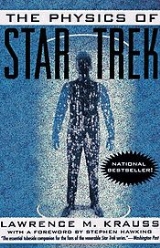
The Physics of Star Trek
Encyclopedia
The Physics of Star Trek is a 1995 nonfiction book by Arizona State University
professor Lawrence M. Krauss
. It discusses the physics
involved in various concepts and objects described in the Star Trek
universe. He investigates the possibility of such things as inertial dampeners and warp drive
, and whether physics as we know it would allow such inventions. He also discusses time travel
, light speed
, pure energy
beings, wormhole
s, and other concepts. The book includes a foreword by astrophysicist Stephen Hawking
.
The Physics of Star Trek was met with generally positive reviews. It became a national bestseller and sold more than 200,000 copies in the United States. As of 1998, it was being translated into 13 different languages. It was also the basis of a BBC television production.
Krauss got the idea for writing the book from his publisher, who initially suggested it as a joke. Krauss dismissed the idea but later thought that using Star Trek might get people interested in real physics.
The hardcover edition was published in November 1995, and a paperback edition followed in September 1996. Krauss's next book, Beyond Star Trek: Physics from Alien Invasions to the End of Time, was published in 1997.
Arizona State University
Arizona State University is a public research university located in the Phoenix Metropolitan Area of the State of Arizona...
professor Lawrence M. Krauss
Lawrence M. Krauss
Lawrence Maxwell Krauss is an American theoretical physicist who is professor of physics, Foundation Professor of the School of Earth and Space Exploration, and director of the Origins Project at the Arizona State University. He is the author of several bestselling books, including The Physics of...
. It discusses the physics
Physics
Physics is a natural science that involves the study of matter and its motion through spacetime, along with related concepts such as energy and force. More broadly, it is the general analysis of nature, conducted in order to understand how the universe behaves.Physics is one of the oldest academic...
involved in various concepts and objects described in the Star Trek
Star Trek
Star Trek is an American science fiction entertainment franchise created by Gene Roddenberry. The core of Star Trek is its six television series: The Original Series, The Animated Series, The Next Generation, Deep Space Nine, Voyager, and Enterprise...
universe. He investigates the possibility of such things as inertial dampeners and warp drive
Warp drive (Star Trek)
Warp drive is a faster-than-light propulsion system in the setting of many science fiction works, most notably Star Trek. A spacecraft equipped with a warp drive may travel at velocities greater than that of light by many orders of magnitude, while circumventing the relativistic problem of time...
, and whether physics as we know it would allow such inventions. He also discusses time travel
Time travel
Time travel is the concept of moving between different points in time in a manner analogous to moving between different points in space. Time travel could hypothetically involve moving backward in time to a moment earlier than the starting point, or forward to the future of that point without the...
, light speed
Speed of light
The speed of light in vacuum, usually denoted by c, is a physical constant important in many areas of physics. Its value is 299,792,458 metres per second, a figure that is exact since the length of the metre is defined from this constant and the international standard for time...
, pure energy
Energy
In physics, energy is an indirectly observed quantity. It is often understood as the ability a physical system has to do work on other physical systems...
beings, wormhole
Wormhole
In physics, a wormhole is a hypothetical topological feature of spacetime that would be, fundamentally, a "shortcut" through spacetime. For a simple visual explanation of a wormhole, consider spacetime visualized as a two-dimensional surface. If this surface is folded along a third dimension, it...
s, and other concepts. The book includes a foreword by astrophysicist Stephen Hawking
Stephen Hawking
Stephen William Hawking, CH, CBE, FRS, FRSA is an English theoretical physicist and cosmologist, whose scientific books and public appearances have made him an academic celebrity...
.
The Physics of Star Trek was met with generally positive reviews. It became a national bestseller and sold more than 200,000 copies in the United States. As of 1998, it was being translated into 13 different languages. It was also the basis of a BBC television production.
Krauss got the idea for writing the book from his publisher, who initially suggested it as a joke. Krauss dismissed the idea but later thought that using Star Trek might get people interested in real physics.
The hardcover edition was published in November 1995, and a paperback edition followed in September 1996. Krauss's next book, Beyond Star Trek: Physics from Alien Invasions to the End of Time, was published in 1997.
See also
- Physics and Star TrekPhysics and Star TrekThe science-fiction media franchise Star Trek has borrowed freely from the scientific world to provide storylines. Episodes are replete with references to tachyon beams, baryon sweeps, quantum fluctuations and event horizons...
- The Physics of SuperheroesThe Physics of Superheroes'The Physics of Superheroes' is a popular science book by physics professor and long-time comic-book fan James Kakalios. First published in 2005, it explores the basic laws of physics. Kakalios does not set out to show where the world of superheroes contradicts modern science, granting the heroes...
- Physics of the ImpossiblePhysics of the ImpossiblePublished in 2008, Physics of the Impossible: A Scientific Exploration Into the World of Phasers, Force Fields, Teleportation, and Time Travel is a book by theoretical physicist Michio Kaku. Kaku uses discussion of speculative technologies to introduce topics of fundamental physics to the reader...

